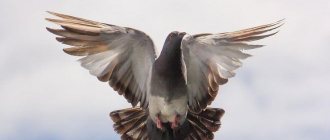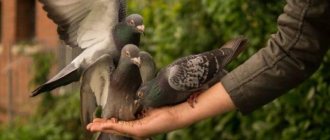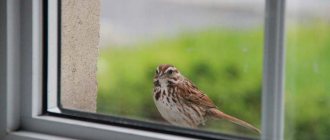Why do birds swim in puddles?
We learned to observe birds and analyze their behavior a long time ago; they were the harbingers of changes in weather conditions.
Birds have a natural intuition that can protect them from bad weather. Having noticed how they swim in puddles, it’s worth wondering what this is connected with. This behavior of birds may mean that they sense the onset of a dry season when they will not be able to get enough water. Therefore, birds take advantage of every moment to saturate the body with life-giving moisture.
Scientific justification will be accepted
Ornithologists have long figured out the reason why sparrows often bathe in a puddle or sand. In this way they are trying to get rid of various lice eaters. These ectoparasites cause a lot of trouble for both adult birds and chicks, and you can get rid of adults and their eggs with water, so sparrows bathe in puddles.
If the water has not yet warmed up, then they try to get rid of lice eaters using sand baths. In addition, fidgeting in the sand helps to scratch the skin, which becomes itchy due to the movements of parasitic insects.
Ornithologists have another explanation for this bird behavior. Due to rising temperatures in summer, sparrows become hot. Therefore, they try to cool off in cool puddles. In addition, dust clogs the coccygeal and supratail sebaceous glands, which is why an insufficient amount of oily substance reaches the plumage. To cleanse the skin, birds take baths.
Folk signs if sparrows bathe in a puddle
Since ancient times, many superstitions and signs have been associated with the habits of sparrows. And this is no coincidence, because by their behavior one can determine an imminent change in the weather. Sparrows swimming in a puddle can be interpreted in different ways, depending on the season when it is observed.
A sign if sparrows bathe in a puddle in the fall
If a sparrow bathing is observed in the fall, then you should expect warm and dry days - this period is also called “Indian summer”, when after the rainy weather characteristic of autumn, warm days begin like summer.
Having seen how the birds are carried away by water procedures, you can safely go on vacation without worrying that a sunny day will be replaced by prolonged rain and a dull mood.
in spring
Sparrows will help determine when the cold will be replaced by a thaw - their swimming in melt waters indicates that the coolness is giving way to the spring sun, and the puddles will soon dry up. If the weather has already recovered after winter, then swimming in puddles promises a hot summer without precipitation.
In summer
If sparrows bathing in the off-season promises a person only joyful moments, then in the summer there is a double feeling: on the one hand, clear summer days speak of a great mood and allow you to thoroughly enjoy warm, even hot, days. On the other hand, this means that a dry season is coming, which can harm crops and lead to a lack of harvest.
Important! On such days, you need to especially carefully monitor your garden and vegetable garden and water more often.
Why in the sand, why in the dust?
Gray birds can swim in summer not only in a puddle, but also in sand or dust. Such swimming indicates that the weather is getting colder, the rains will soon begin and prolonged bad weather will set in. So, dress warmly and take an umbrella with you when going outside. Birds sense the approaching cold, so they try to fill the fluff with dust particles in order to form a light layer of air and preserve the temperature of their body.
There are other explanations about swimming in the sand:
- Seeing sparrows swimming in the sand means you will soon come face to face with an unknown enemy.
- If you swim with other birds, difficult trials are approaching you.
- A small group of birds is fiddling around in the dust - expect good luck in business.
- To notice first a dusty bath, and then in a puddle of water - changes will soon come on the love front.
Attention! Don't blame sparrows for bad news and troubles. Birds do not bring misfortune, but only warn people against it, thereby making it possible to better prepare for the impending problem.
Little gray birds are little messengers, warning about changes in the weather, as well as significant changes in fate. Understanding folk beliefs and observing your feathered neighbors will help you formulate a correct forecast, as well as find out about upcoming events.
We recommend: The sign of a “dead dove”: what does it mean, why does the bird dream, what to do to avoid the consequences?
Signs if sparrows bathe in dust and sand
There is an opposite sign by which you can track changes in the weather: sparrows bathe in dust. As a rule, this means that the sun will soon be covered by gray clouds and a rainy period will begin.
It is worth noting that the behavior of birds warns humans, so following folk signs can be very useful. While the birds devote themselves to breeding and sit in the nests, various pests appear in the plumage: lice or lice-eating insects. To get rid of the unbearable itching that spreads throughout the body, sparrows bathe in dust or sand.
Other signs about the sparrow
By analyzing the behavior of sparrows, you can learn a lot of interesting things, it doesn’t have to be swimming:
- birds begin to build nests - the day will be calm and sunny;
- sparrows fly low above the ground - you should be wary of worsening weather and the imminent start of rain and thunderstorms;
- a bird circling overhead is a messenger promising good news, family well-being and harmony;
- sparrows make nests on the roof of a young unmarried girl’s house - for an imminent wedding;
- Excessive chirping in winter can mean frost and heavy snowfall.
Birds have very keenly developed instincts, so they sense changes in the weather earlier than people.
Signs associated with bird bathing
Winged creatures have long become weather forecasters. Their behavior can warn of rain or lack thereof.
When sparrows bathe in a puddle, they sense the approaching drought and replenish their water supply. This behavior of land birds indicates hot weather and lack of rain.
If pigeons bathe in a puddle, not everyone considers this as a sign, because birds love water treatments. Pigeon bathing promises warm, sultry days.
In a puddle
You can often see sparrows actively swimming in a puddle; superstitious people have several signs about this:
- Birds feel the approaching drought, the end of the rainy period, so they try to get enough of the escaping moisture. For people, this is a very alarming sign, since dry weather is harmful to crops.
- Swimming in the warm season foreshadows a short and mild winter.
READ Sneezer by time: signs for fortune telling and detailed interpretation
There are other non-weather related items:
- Bathing one or three sparrows means changes in relationships. Most likely, the person will meet a new partner.
- A flock of birds floundering in the water - this promises wealth, which will be replaced by a crisis.
- A sparrow bathing with pigeons promises career growth.
- If there are jackdaws in the company of birds, then good news is expected from loved ones.
- Magpie will bring a cash bonus.
In sand or dust
When small nimble birds get dirty on the road, people wonder what the consequences of cheerful sparrows bathing in dust will lead to. It turns out that the behavior of birds can tell a person what kind of weather to expect. Superstitions accurately noted the relationship between these two factors. Nature warns of a change in the weather - the rainy season will come.
If sparrows continually bathe in a pile of sand, this phenomenon indicates the approach of various events:
- Several birds get dirty in the dust - expect to meet an opponent.
- A flock floundering in the sand means good luck.
- Swimming with other birds promises bad news.
Signs if pigeons are swimming in a puddle
Since ancient times, pigeons have been considered birds that bring God's grace and peace. Signs associated with these birds sometimes cope even better with weather forecasts than meteorologists. Not many people attach importance to pigeons swimming in a puddle - after all, these representatives of birds love water very much.
Important! Based on the behavior of pigeons, one can easily predict changes in temperature, cessation of rain, and the onset of drought.
A sign if pigeons bathe in a puddle in the fall
The autumn water procedures of pigeons may mean that the dullness of everyday life will be replaced by the onset of the long-awaited “Indian summer”, which will delight you with warm sunny days.
This is a great opportunity to spend time in nature, relaxing not only your body, but also your soul. In addition, pigeons bathing in the fall foreshadows a warm and dry winter.
in spring
Pigeons swimming at the beginning of spring indicates an imminent thaw. The air temperature characteristic of winter will be replaced by warmth. Nature will begin to turn green and come to life.
If the pigeons bathe at the end of spring, then you should not expect a rainy summer - it will be dry, so you will have to try hard to harvest a good harvest.
In summer
Pigeons bathing in puddles in the summer foreshadow the imminent cessation of rains and the onset of drought. When leaving home, you don’t need to take an umbrella with you - you won’t need it. Summer residents will have a hard time - garden crops will require more effort.
Important! Pigeons swimming at the end of summer may indicate a warm and dry autumn, which means that Indian summer is just around the corner.
Interpretation of signs
Each season of the year leaves its mark on the behavior of birds. Therefore, it is worth following what signs of the weather naturally lead to peculiarities in their behavior and why sparrows bathe in a puddle at different times of the year.
in spring
Seeing sparrows swimming in a puddle in the spring, it is clear that:
- You can safely put your fur coats in the closet. This sign promises dry and sunny weather for at least a week.
- If sparrows scream loudly and bathe, then you can expect strong winds.
In summer
Sparrows swimming in a puddle in the summer are a sure sign that this puddle will soon dry up and hot and dry weather will come. It will be sunny, even hot.
Gray birds swim in the summer not only in water, but also in dust and sand. The consequences of such bathing are different - this procedure is carried out by birds before cold weather, rain and prolonged bad weather.
Having noticed a sparrow swimming in the dust, you need to dress warmly and take an umbrella.
in autumn
In autumn, birds swimming in a puddle should please:
- Indian summer is approaching, you will still be able to bask in the sun and prolong the pleasure of the summer season. Although it is quite rare to see swimming, birds try to eat more in the fall in order to create a layer of fat for the winter cold.
- Sparrows splash in puddles in early autumn, when summer is not quite over, and the sign can be attributed to summer predictions.
in winter
If sparrows swim in a puddle in winter, it is clear that the weather is abnormally warm. This is more of an anomaly than a regular sign, so you shouldn’t pay special attention to it. And yet:
- if you managed to see such a signal, then it is clear that the thaw will soon be replaced by clear and therefore cold weather;
- there is another winter sign - if the sparrows scream loudly, then there will be snow;
- if they gather in flocks, then it means warmth;
- when they hide under roofs and sit quietly, this means a blizzard.
Why do other birds swim in puddles: signs
Not only sparrows and pigeons love to swim in puddles, but also other representatives of the class of birds. Signs associated with swallows or birds of a feather are quite common.
If it becomes noticeable that land birds are reaching for water, then we should expect the onset of a dry period. Birds intuitively sense changes in weather conditions, so they rush to swim in puddles to stock up on moisture, which they will soon lack.
Having noticed how the birds have changed their high flight to swimming in puddles, you can forget about the umbrella and rubber boots - in the near future the weather will recover and the sun will come out from behind the clouds.
Scientific explanation
Although the behavior of birds is associated with a lot of superstitions, ornithologists have their own point of view on this matter. If you want to know why sparrows like to swim in sand and dust, let's turn to biology.
READ What to prepare for if your right or left eyebrow itches: interpretation of the sign
During the hatching period, the birds get lice and other insects, so they try to get rid of them using mud procedures. Parasite activity increases during periods of low atmospheric pressure before rain. By wallowing on the ground, birds eliminate pests and clean their feathers. This is a way to relieve the unbearable itch - that's why sparrows bathe in mud and sand.
A nimble sparrow warns of weather changes by swimming. The birds will tell you when you need to take an umbrella with you or prepare for a hot period. You may not associate their behavior with the weather, but it’s still worth using the advice of natural weather forecasters.











